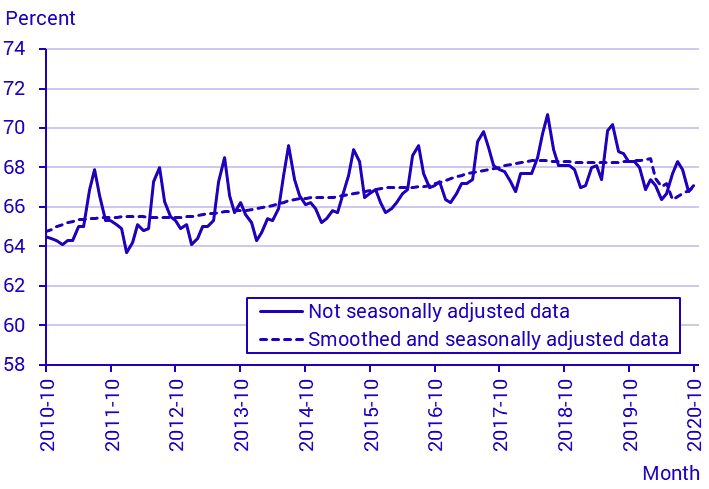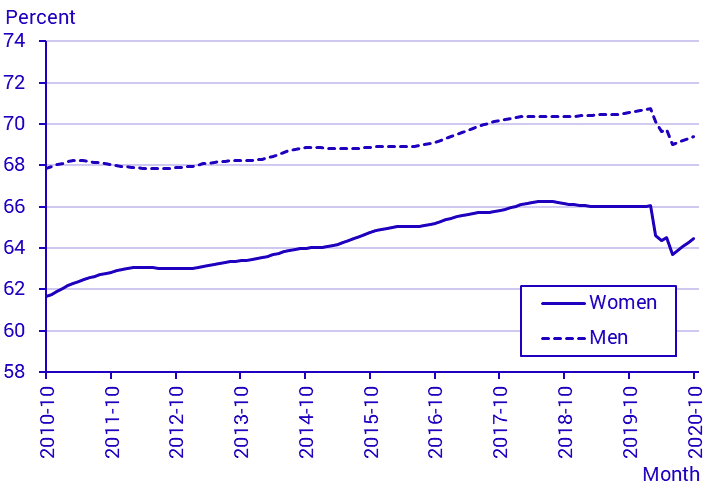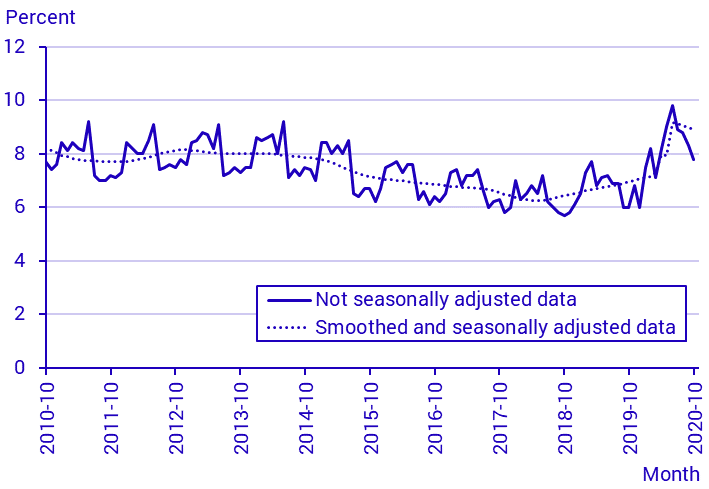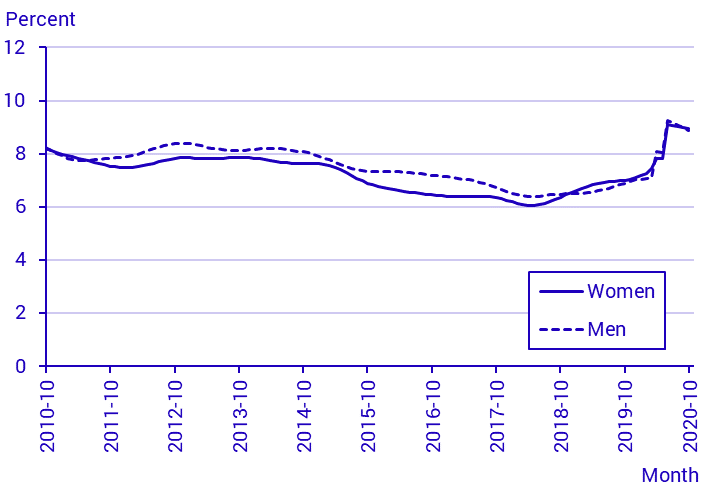Labour Force Surveys (LFS), October 2020
Subdued labour market with signs of improvement
Statistical news from Statistics Sweden 2020-11-19 9.30
In October 2020, there were 5 062 000 employed people, which is 76 000 fewer than in October 2019. The number of unemployed people increased by 101 000 to 430 000. This corresponds to an unemployment rate of 7.8 percent, up by 1.8 percentage points. The average number of hours worked was 165.3 million hours per week, which corresponds to a decrease of 4.1 percent, calendar-adjusted. Seasonally adjusted and smoothed data shows that both employment and unemployment have stabilised and that there are indications of an improved labour market situation. The unemployment rate was 8.9 percent.
The labour force
In October 2020, there were 5 492 000 people aged 15–74 years in the labour force, not seasonally adjusted. There were 2 914 000 men and 2 578 000 women in the labour force. The relative labour force participation rate was 72.8 percent. Among women this rate was 69.6 percent and among men the rate was 75.9 percent. There were 564 000 young people aged 15–24 years in the labour force. The relative labour force participation rate for young people was 48.9 percent.
According to seasonally adjusted and smoothed data, there were 5 543 000 people in the labour force and the labour force participation rate was 73.5 percent. Both the number of people in the labour force and the labour force participation rate have recovered from the lowest figures in March. The levels in October were comparable to February, when the effects of COVID-19 were not yet discernible in the Swedish labour market.
Employment
In October 2020, there were 5 062 000 employed people aged 15–74 years, not seasonally adjusted, which is 76 000 fewer than in the same month a year ago. There were 2 381 000 employed women, a decrease of 62 000, and 2 681 000 employed men. The employment rate decreased by 1.2 percentage points and amounted to 67.1 percent. For women the rate dropped by 1.8 percentage points and amounted to 64.3 percent, and for men the rate was 69.9 percent. There were 447 000 employed young people aged 15–24 years and the employment rate among young people was 38.8 percent.
According to seasonally adjusted and smoothed data, there were 5 050 000 employed people. This is a decrease of 105 000 people, of whom 58 000 were young people, compared with February 2020. The employment rate was 67.0 percent, which is 1.5 percentage points less than in February 2020. However, since the lowest figure in June, there have now been signs of an upturn in employment.
Employees
In October 2020, there were 4 552 000 employees, according to non- seasonally adjusted data. There were 3 867 000 permanent employees and 685 000 temporary employees.
Compared with February 2020, seasonally adjusted and smoothed data shows a decrease of 97 000 employees, of whom 24 000 were permanent employees, while 73 000 were temporary employees. As with the employment rate, there are signs of improvement compared with June, when the lowest figure was noted.
Hours worked
In October 2020, the average number of hours worked was 165.3 million per week, not seasonally adjusted. In calendar-adjusted figures, this corresponds to a decrease of 4.1 percent compared with the corresponding month a year ago.
Seasonally adjusted and smoothed data shows that the average number of hours worked per week was 147.8 million, which is 8.1 million hours per week less than in February 2020. In 2020, the smallest number of hours worked per week was noted in April; since then, this figure has increased by 4.3 million hours.
In work and absence
There were 4 585 000 people employed and in work in October 2020, not seasonally adjusted. Calendar-adjusted, this corresponds to a decrease of 2.3 percent compared with the same month a year ago.
The LFS estimates the number of people who were absent from their principal occupation for the whole week or for part of the week by main reason for absence. In October 2020, this figure was 1 308 000. There were 488 000 people absent for the whole week in October 2020, not seasonally adjusted. Among these, 153 000 were absent due to illness, while 17 000 were absent for the whole week due to lack of work. There were 83 000 people absent due to holidays.
People who are absent due to lack of work or lay-offs are often absent for only part of the week. There were 77 000 people in total absent for the whole week or part of the week due to lay-offs. There were 61 000 people who stated lack of work as their main reason for absence.
Seasonally adjusted and smoothed data showed that there were 4 245 000 people in work, which is 121 000 fewer than in February 2020. There were 805 000 people absent for the entire week. In 2020, the lowest number of employed people in work was recorded in April. Since April, this figure has increased by 138 000 people.
Unemployment
In October 2020, there were 430 000 unemployed people aged 15–74 years, not seasonally adjusted, which is 101 000 more than in the corresponding month a year ago. This corresponds to an unemployment rate of 7.8 percent, which is an increase of 1.8 percentage points. The number of unemployed men increased by 59 000 and amounted to 233 000, and the number of unemployed women increased by 42 000 and amounted to 197 000. Among men, the unemployment rate increased by 1.9 percentage points to 8.0 percent and among women the unemployment rate increased by 1.7 percentage points to 7.7 percent. There were 117 000 unemployed young people aged 15–24 years, which corresponds to a youth unemployment of 20.7 percent.
Among people aged 15–74 years, seasonally adjusted and smoothed data shows an increase of 97 000 unemployed people, and an increase of 1.8 percentage points in the unemployment rate compared with February 2020. In October 2020, there were 494 000 unemployed people, which corresponds to an unemployment rate of 8.9 percent. However, seasonally adjusted and smoothed data showed minor changes in unemployment since June, when the highest unemployment rate in 2020 was noted. Among young people aged 15–24 years, seasonally adjusted and smoothed data shows an increase in both the number and proportion of unemployed people compared with February 2020. The number of unemployed young people increased by 26 000 and amounted to 152 000, and the unemployment rate increased by 5.5 percentage points to 25.5 percent.
Impact of COVID-19 on the labour market
In view of the coronavirus (COVID-19) pandemic, questions about the impact of COVID-19 have been added to the LFS. The answers to these questions show that 66 000 employed people aged 15–74 years were absent during the whole reference week in October related to COVID-19. This means that among people who were absent during the entire reference week, 13.8 percent were absent due to COVID-19. This proportion was 18.0 percent for men and 10.3 percent for women.
Among employees aged 15–74 years who were absent during the entire reference week, 12.2 percent, which corresponds to 53 000 people, stated that their absence was related to COVID-19. This proportion was 14.8 percent for men and 10.3 percent for women. Furthermore, 22.8 percent of employees who were absent during part of the week, 158 000 people, stated that their absence was related to COVID-19. Among self-employed persons and assisting household members aged 15–74 years, 37.5 percent felt that they had less work due to the coronavirus pandemic, while 18.2 percent felt that they had more work.
To be classified as unemployed in the LFS, a person must be without a job, must be able to start work and must have sought work. This means that people who are without a job, but who have not been seeking work or are unable to start work are not classified as unemployed, but are classified, instead, as not in the labour force. In October 2020, there were 2 049 000 people aged 15–74 years outside the labour force. Among these, 42 000 people stated that they would have been able to work, but had not sought work due to COVID-19.




Next publishing will be
2020-12-17 at 9:30.
Feel free to use the facts from this statistical news but remember to state Source: Statistics Sweden.
